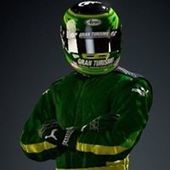Quoteif this clutchTorque is used to drive the wheels, then there will be torque only if there is different in engineSpeed and wheelSpeed, ie torque is highest if clutch is slipping like crazy, which is not correct. And since this torque is fed back to the engine, then the engine speed would going up and down in a unrealistic manner.
Using that linear model you are simulating something closer to a torque converter (fluid coupling used in automatic transmissions) rather than a clutch. So that's why there's lots of slipping.
This can be ok, maybe you just need "stiffer" constants:
clutchTorque = 50.0f * (engineRPM - drivelineRPM)...
//or
clutchTorque = (engineRPM - drivelineRPM)^2 ...
//etcOr if you just do:
if(engineSpeed > drivelineSpeed)
clutchTorque = blah;
else
clutchTorque = -blah;Then you will have lots of torque as soon as you have 0.00001 slip. You might need a combination of the two to get enough clutch "grab" but not have an unstable simulation.
QuoteAnother thing is that the engine torque does not go to the wheels but only the reaction torque does, which is
On 1/27/2018 at 4:37 PM, CombatWombat said:clutchTorque = frictionConstant * clutchFactor;
which is a very small amount of torque.
Why is it a small amount? You get to choose the frictionConstant to be whatever you desire.
Maybe I confused you with using frictionConstant as the name. I did not mean to suggest using something like 0.5 mu friction coefficient. A real clutch has friction coefficient (0.5ish), heavy springs (~5000N+ normal force), and a mean radius (~0.125m) = ~312Nm. Using something like 500-1000 for frictionConstant is not unreasonable.
QuoteLooking at the diagram (which is the best by the way), the way I understand it is that the engineNetTorque drives the flywheel, which is sideA. A fraction (0 - 100%) of that torque must affect/output to sideB, and how much of engineNetTorque is going to sideB depends on the amount of space in between sideA and sideB.
engineNetTorque drives the whole engine blob of mass. Full stop. Period. Do not confuse yourself with fractions of anything. SideB of the clutch doesn't know what engine is doing. It has no idea if there is an engine there at all. Maybe its a hamster in a wheel. Doesn't matter. SideB only knows that SideA is rubbing against it with some normal force and coefficient of friction.
QuoteI'm using (Unity3D), there is no way to extract roadReactionTorque at the wheel to feed back on the engine,
You don't have to.
You have some torque acting on SideB of the clutch (again, because SideA is rubbing against it, nothing to do with engine). That gets multiplied by the gearbox. You give this to your UnityWheelThing, it performs integration and has a new speed. Next frame, you read that speed, multiply it by gearbox ratio, and that becomes the new speed for clutch-side-B.








